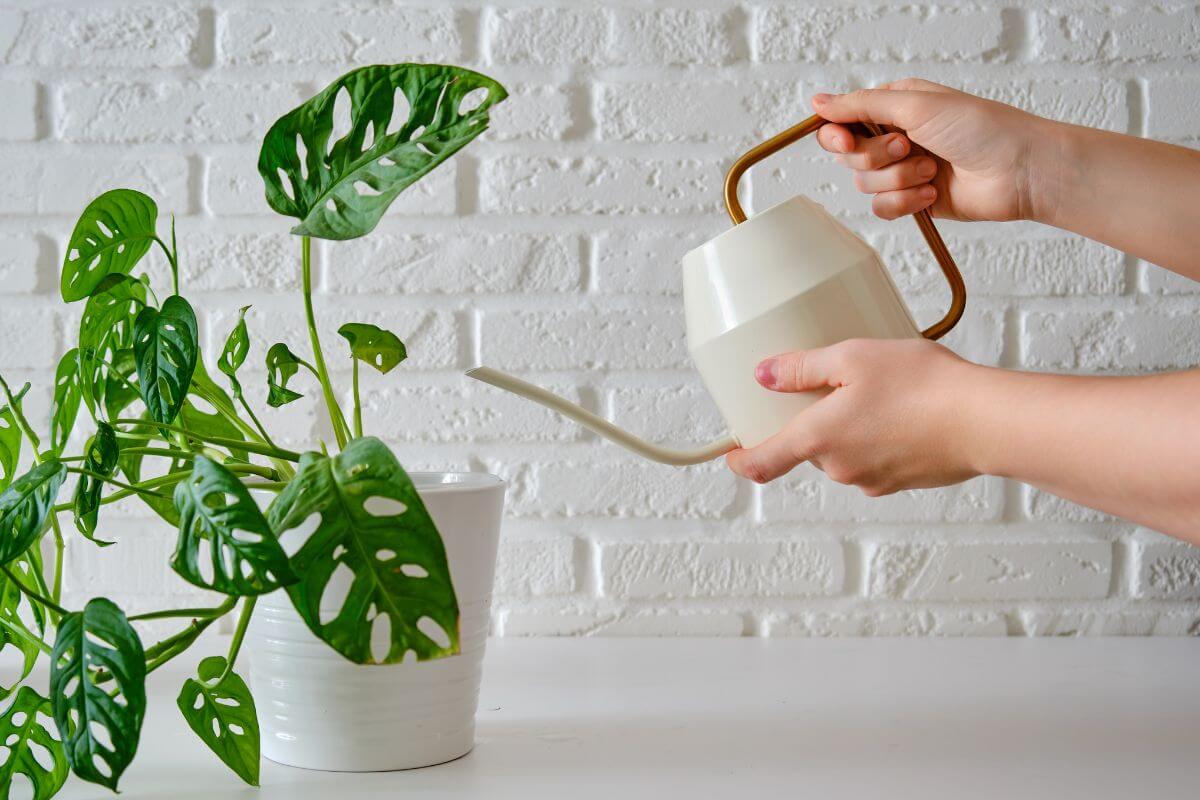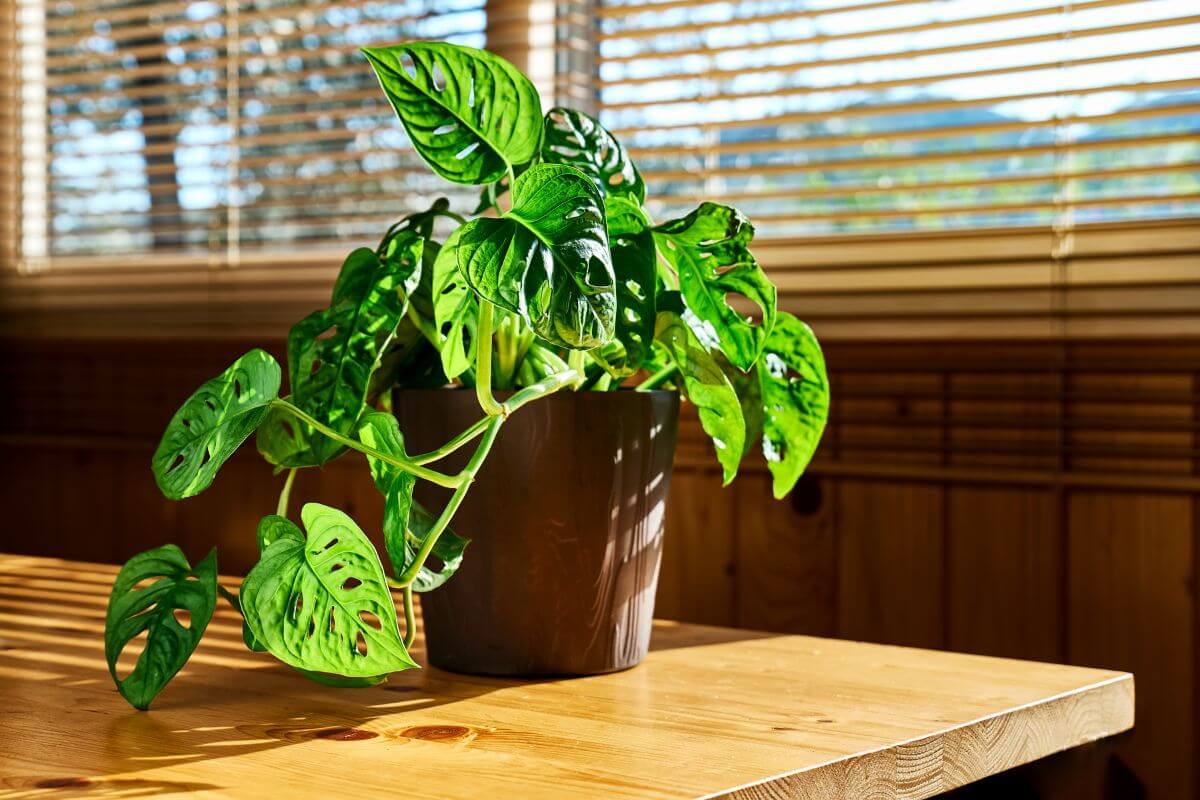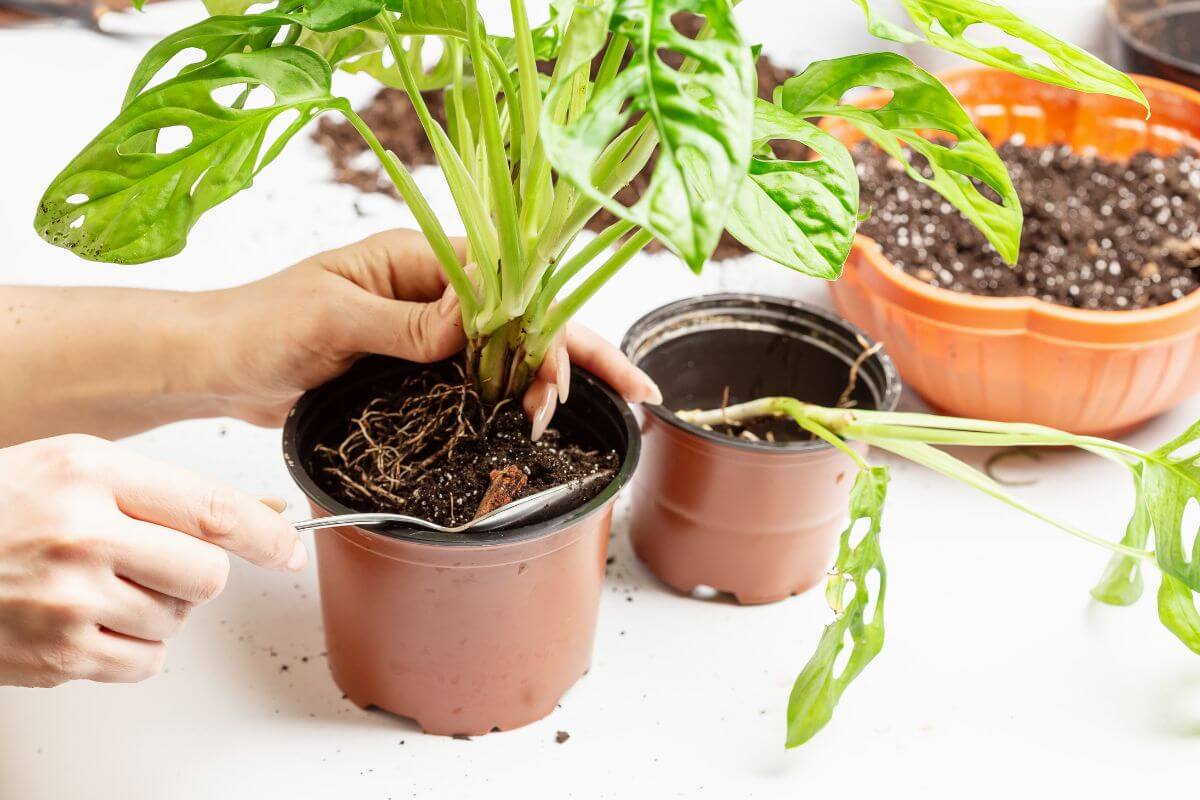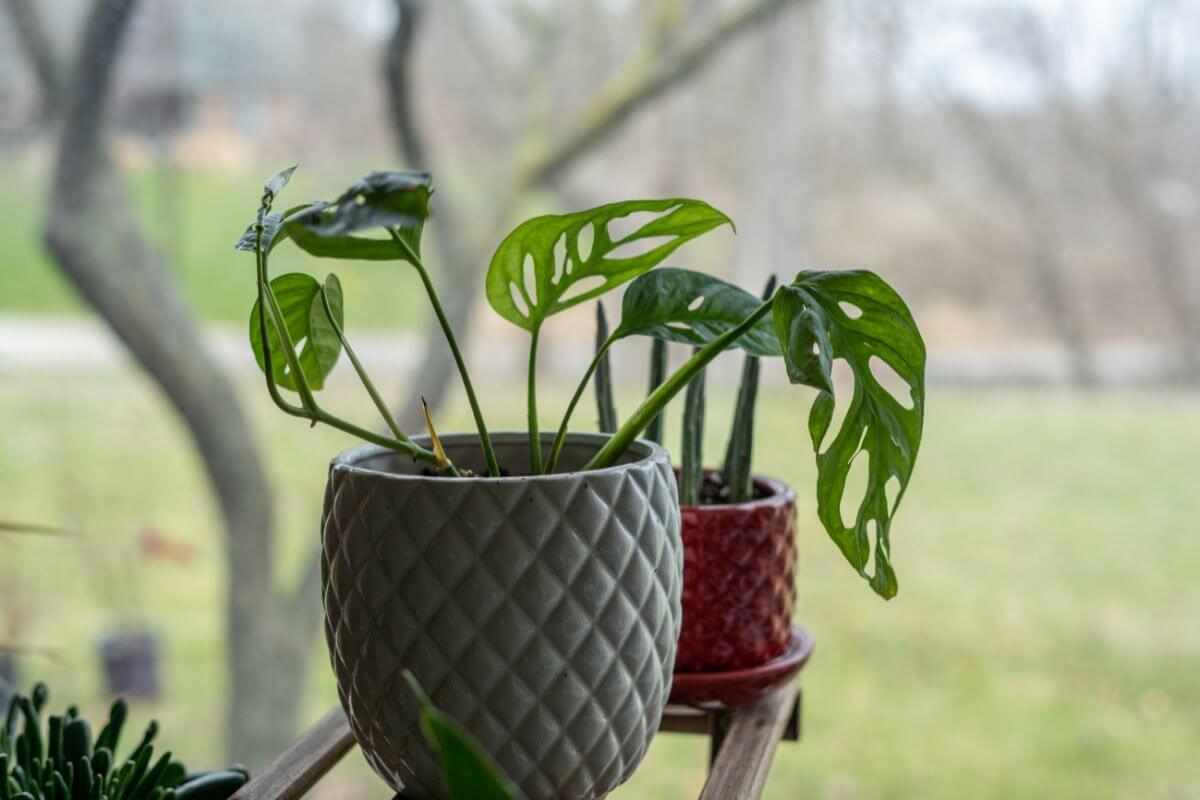A few years ago, I was looking for a new houseplant to add to my collection. I wanted something unique and different. I came across a picture of a plant called “Swiss cheese plant” and fell in love with it. It looked so cool and interesting.
The Swiss Cheese Plant is an easy-to-grow indoor or outdoor plant. This guide will show you how to care for the Swiss Cheese Plant.
Swiss Cheese Plant Overview

The tropical Monstera adansonii, or Monstera deliciosa, is native to Central and South America. They are better recognized by their popular name of the “Swiss Cheese Plant.”
The M. adansonii has large leaves shaped like hearts that will develop holes, known as fenestration, as it ages. These large holey leaves resemble swiss cheese, hence its name.
A part of the Aracee family, there are a few monstera plants that are all called Swiss cheese plants, The plant genus is “Monstera”. The most common of the Monstera plants is the Monstera deliciosa, also referred to as the Split-leaf Philodendron, which tends to have lobed leaves with long holes.
There is also the Monstera obliqua that is actually quite rare, and its holes are so large that it appears to have more holes than leaf. It has an appearance that resembles green lace.
When cultivating a Swiss cheese plant indoors, you can plant it at any time of the year. Typically, seedlings or plantlets will be purchased from nurseries for cultivation.
This tropical perennial is a favorite as a houseplant and is very easy to care for. It is a climber though, so it will need a trellis, moss pole, or a stake for it to cling to when climbing.
The plant boasts rapid growth and can reach impressive heights in no time.
Indoors, the plant can grow from one to three feet wide and six to eight feet tall. Outdoors, they can grow to seventy feet tall and will flower producing white blooms.
Swiss Cheese Plant Care Guide
The Swiss cheese plant is an ornamental houseplant characterized by aerial roots that grow in a downward direction from the stem.
These roots will seek support by clasping to the ground or whatever they find to lean on. They’re similar to a vining plant.
In their natural outdoor habitat, these plants use these roots to push upward to latch on to trees or other vegetation. If you wish to replicate the natural habitat indoors, place a stick or pole in the center of its container.
Soil for the Swiss Cheese Plant
Soil that is peat-based is the recommended soil for cultivating these plants. The peat will help keep moisture in the soil, while avoiding sogginess and root rot. Pots and containers should have good drainage holes.
The soil pH level should be neutral to acidic, in the pH 5.5 to 7.0 range.
Light for the Swiss Cheese Plant

As a tropical houseplant, the Swiss cheese enjoys bright indirect light and partial shade. They usually grow underneath large jungle trees in the tropics. Therefore, they should not be excessively exposed to direct sunlight, to prevent scorching of the leaves.
If you wish to provide a bit of direct sun, it should be done in the morning and for no longer than three hours.
Water and Humidity for the Swiss Cheese Plant
Your Swiss cheese plant should have a soil bed that is always moist, but never waterlogged or soggy. To be sure about when to water your plant, place your finger in the soil bed. If the soil is dry to about an inch deep, it is time to water your plant.
As a jungle plant, the Swiss cheese will thrive in high humidity. Many of these plants are cultivated in greenhouses or conservatories.
The more your environment replicates its natural habitat, the better. Bright, warm bathrooms and kitchens are ideal for humidity.
If your plant’s location does not offer high humidity, you can help it by misting the plant often. Other solutions include the use of a humidifier or a tray filled with pebbles and water.
The plant should be placed on the tray but always above the waterline. The container should not come into contact with the water in the tray though.
The pebble tray will help create a microclimate with increased humidity as the water evaporates.
You can also place a receptacle filled with water near the plant. Grouping plants together that enjoy humidity will help create a natural humidity cap.
Temperature for the Swiss Cheese Plant
The Swiss cheese plant will do well if the temperature does not drop below 60° Fahrenheit. It is able to survive brief bouts of cold, but with some die-back resulting.
Fertilization for the Swiss Cheese Plant
When the Swiss cheese plant has been potted for the first time or repotted, you should wait approximately six months before fertilizing. The potting soil will initially feed your plant adequately.
After six months, begin to fertilize your plant once a month with a liquid fertilizer that has been diluted to half strength.
Pruning and Repotting the Swiss Cheese Plant

Pruning is normal for Swiss cheese plants because it is a climber and vine-like. If growth is too much for your space or your plant begins to look unruly, prune it.
Pruning is best done in the spring or fall by snipping top growth and any damaged leaves. Dead leaves should also be removed. Always trim close to the stem to avoid unsightly stubs.
Your mature Swiss cheese plant should be repotted every other year, while younger plants can be repotted annually. For mature plants, the soil bed should be substituted annually.
If they do not have sufficient nutrients in the soil bed, growth will suffer. Because they produce stiff roots from their stems, repotting can be challenging.
Here’s how to repot the Swiss cheese plant:
- Choose a pot that is two to three inches larger than the root ball to repot the plant in.
- Fill a third with soil mixture.
- Place the stake or pole in the center of the pot.
- Now position your plant in the soil.
- Fill in the pot with soil mix to just above where the plant’s former soil line was located.
- Firm up the soil bed and use plant ties to tie the plant to its pole, stake, or trellis.
Propagating the Swiss Cheese plant
The easiest method for propagating your plant is to use stem cuttings treated with rooting hormone, or by placing them in water for several weeks.
Cuttings should be taken from the plant after a leaf node. Remove the leaves on the bottom of your cutting. Treat the cut end with rooting hormone and place it in a container with warm moist soil.
If you choose water, once the roots are there, plant the cuttings in potting soil.
Swiss Cheese Plant Toxicity and Pets
The Swiss cheese plant is toxic to both dogs and cats, as well as small animals in general. All parts of the plant contain insoluble calcium oxalate crystals.
If a house pet or a small child bites one of these leaves, the oxalate crystals will be released and may irritate the mouth, causing it to swell as well as the lips, palate, tongue, and throat.
In some extreme cases, swelling may cause the upper airway to partially close or completely close, making breathing difficult or impossible.
The best solution is prevention. Keep your plant away from children and pets. Should they bite, chew, or ingest this plant, contact your local poison control unit, your doctor, or your veterinarian immediately.
Symptoms of calcium oxalate poisoning may include:
- Swelling
- Diarrhea
- Excessive drooling
- Blistering inside the mouth or in the throat
- Lack of appetite
- Difficulty swallowing
- Pain in the mouth or throat and pawing at the mouth
- Vomiting
Swiss Cheese Plant Pests, Diseases, and Problems

Swiss cheese plants are similar to other houseplants when it comes to pests. They are susceptible to aphids, spider mites, mealybugs, whitefly, and scale insects.
If you find evidence of a pest infestation, treat your plant immediately with organic insecticidal soap, an organic non-toxic insecticide, or neem oil. Scale, which appear as a waxy substance on stems, can be removed directly from the plant by using a cotton swab dipped in rubbing alcohol.
Common diseases for the Swiss cheese plant include root and stem rot, powdery mildew, and rust.
They are susceptible to leaf spot, which will cause yellow or brown spots on leaves. These are fungi that have taken up residence on your plant’s foliage. A copper-based spray fungicide can resolve the problem.
The color of the plant’s leaves will give an indication of problems. Yellow leaves will indicate overwatering or a lack of nutrients. Brown leaves tell you that your plant may need more water or higher humidity.
If the leaves do not split or develop holes, they may need more light. Also, curling leaves may indicate thirst.
When considering underwatering as the source of a problem, it might not be sufficient to just give more water. Along with humidity levels, see if the soil bed is too compacted or if the plant is root-bound.
If the soil is compacted, the plant may not absorb water. This is also the case if the plant is too root-bound, and roots are wrapped tightly. They may not be able to absorb the water you are giving them.
Swiss Cheese Plant Care Final Thoughts
With its attractive, outsized glossy green leaves, whether a Monstera adansonii or a Monstera deliciosa, this striking houseplant is a beautiful addition to the home or office.
As a low-maintenance, easy-care plant, it is great for beginning gardeners.
For other easy to care to houseplant guides, check these out:
- Shamrock Plant Care and Grow Guide
- Nerve Plant Care and Grow Guide
- Polka Dot Plant Care and Grow Guide
Swiss Cheese Plant Care FAQs
How much light does a Swiss cheese plant need?
The Swiss cheese plant needs bright indirect sunlight throughout most of the day. Don’t expose it to direct light as that can lead to scorched leaves.
Is the Swiss cheese plant indoor or outdoor?
The Swiss cheese plant is both an indoor and outdoor plant. It likes warm temperatures and moist conditions. The best time to bring it inside during winter months is after dark. If brought indoors before dusk, keep it near a south facing window where there is plenty of natural lighting. In summertime, move it outside once the sun goes down so it doesn’t get hot.
How often should you water Swiss cheese plant?
Swiss cheese plants should be watered regularly. You don’t want to overdo it because then you risk causing the plant stress. Keep the potting mix slightly damp all the time. When watering, don’t let the roots become soggy and have it turn to root rot.
What is the difference between Swiss cheese plant and Monstera?
There is actually no difference between the Swiss cheese plant and Monstera. Both species belong in the same genus and share similar characteristics. They have similar soil, light, and water needs. In addition, their growth habits are very similar. However, one thing that sets them apart from each other is how they look. While Monsteras tend to have smaller flowers than the Swiss cheeses, they still make excellent additions to any room.
Is the Swiss cheese plant poisonous to dogs?
Yes, the Swiss cheese plant is poisonous to dogs, cats, and humans due to its calcium oxalate content. If you see your pets or children experience any of these symptoms, be sure to call poison control, doctor, or veterinarian: drooling, swelling, blistering, or vomiting.
Can Swiss cheese plants grow in water?
Yes, Swiss cheese plants can grow in water. Avoid using tap water since it may contain chlorine, which will kill the plant. Use distilled water instead. Over time, the roots will absorb some nutrients through osmosis. Be sure to keep it in a bright location and change the water out regularly.
Are Swiss cheese plants easy to care for?
Yes, Swiss cheese plants are relatively simple to take care of. Just remember not to overwater them. Water only when necessary. Also, avoid fertilizing with too many chemicals. Instead use organic fertilizer such as fish emulsion. Finally, do not allow the plant to dry out completely. That could cause damage to the leaves.


